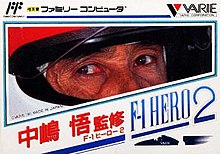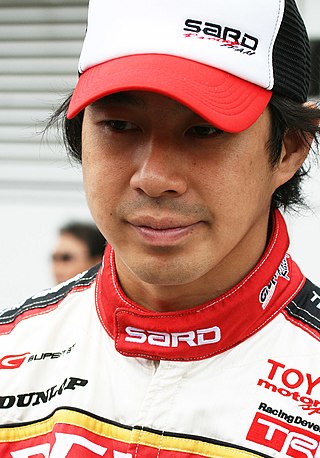
Toranosuke "Tora" Takagi is a Japanese former racing driver.

The 1990 Brazilian Grand Prix was a Formula One motor race held at Interlagos, São Paulo on 25 March 1990. It was the second race of the 1990 Formula One World Championship. It was also the first Brazilian Grand Prix to be held at Interlagos since 1980, following the renovation and shortening of the circuit and the ascendancy of São Paulo driver Ayrton Senna.

The 1991 San Marino Grand Prix was a Formula One motor race held at Imola on 28 April 1991. It was the third race of the 1991 Formula One World Championship.

Satoru Nakajima is a Japanese former racing driver. He is a five-time Japanese Top Formula champion, and was the first full-time Japanese Formula One driver. Accordingly, he is responsible for several firsts for Japanese drivers in Formula One, including being the first to score championship points, and being the first to record a fastest lap.

SD F-1 Grand Prix is a Japan-exclusive video game based on the F1 Grand Prix series. This video game spin-off was developed for the Super Famicom by Video System.
Satoru Nakajima F-1 Hero is a video game developed by Human Entertainment released for the Nintendo Entertainment System in 1990. It starred American Indy car driver Michael Andretti, and featured the full sixteen-race schedule of the FIA Formula One World Championship circuit.

The Lotus 99T is a Formula One car designed by Gérard Ducarouge for use by Lotus in the 1987 Formula One World Championship.

The Lotus 100T is a Formula One car designed by Gérard Ducarouge and Martin Ogilvie for Team Lotus, and used in the 1988 Formula One World Championship. The 100T was an update of the previous Lotus 99T model; technically the car was virtually unchanged, except for the ditching of the active suspension for a conventional setup, and a redesigned nose and rear bodywork. The car was powered by the same, 640 bhp, 1.5L turbocharged Honda V6 engine that powered the McLaren team to 15 wins in 16 races in 1988. The car was driven by reigning World Champion Nelson Piquet, and Japanese driver Satoru Nakajima.
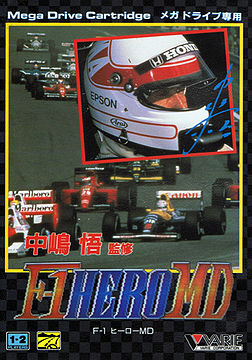
Nakajima Satoru Kanshuu F1 Hero MD is a Formula One video game endorsed by Satoru Nakajima that was released in 1992 for the Mega Drive/Genesis, Nintendo Entertainment System, and Nintendo Game Boy. The North American and European versions of the game are known as Ferrari Grand Prix Challenge in reference to Ferrari, specifically their Formula One team.

Fastest 1 (ファステスト・ワン) is a Sega Mega Drive racing game video game released in 1991 exclusively in Japan. During the release of this video game, other Formula One video games like Super Monaco GP had caused a general increase of demand for Formula One video games. While most of those games were poor simulations of the races, Fastest One proved to be the most realistic of the era.
Varie (バリエ) was a Japanese corporation that developed and published games for the Game Boy, Famicom, the Super Famicom, and the Sega Mega Drive during the 1980s and the 1990s. It was founded in 1986 and closed in early 1997.

Nakajima Satoru Kanshuu F1 Grand Prix is a 1991 Sega Mega Drive Formula One video game based on the career of Satoru Nakajima, who was the first full-time Japanese racer in the history of Formula One. In fact, this was the first game that Nakajima endorsed for a Japanese video gaming system. The entire 1991 Formula One season can be re-enacted with any of the notable contenders from the prestigious Formula One racing organization.

F1 Pole Position is a 1992 racing video game for the SNES, developed by Human Entertainment and published by them in Japan, while the other versions were handled by Ubisoft. It is the first game in the Human Grand Prix/F1 Pole Position series, which features Formula One licensing.
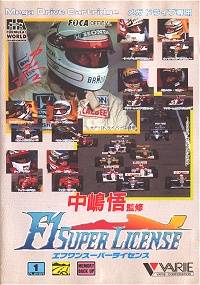
Nakajima Satoru Kanshū F1 Super License is a 1992 racing video game for the Sega Mega Drive that allows for either single season or exhibition modes of play. The object of the game is to acquire the championship for the 1992 Formula One season. There is an official FOCA license and uses a top-down view.

Satoru Nakajima F-1 Hero GB World Championship '91 is a 1991 Japan-exclusive Game Boy Formula One video game published by Varie, endorsed by Satoru Nakajima, who was the first full-time Japanese racer in the history of Formula One. Apart from Nakajima, the actual names of the drivers are not used due to licensing arrangements.

F1 Circus is a series of Formula One-based racing video games developed and published by Nichibutsu starting on the PC Engine in 1990.

Tail to Nose: Great Championship, known in Japan as Super Formula: Chijō Saisoku no Battle, is a 1989 Formula One-based arcade racing video game developed and published by Video System.
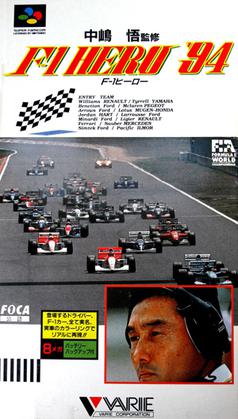
Nakajima Satoru F-1 Hero '94 is a 1994 Japan-exclusive Super Famicom Formula One arcade racing video game licensed by Satoru Nakajima and by FOCA to Fuji Television. This was the sequel to Super F1 Hero and the last game endorsed by Nakajima.
Heros Racing was a Japanese motor racing team which competed briefly in Formula One in the 1976 and 1977 seasons. The team entered the 1976 and 1977 Japanese Grands Prix, each time with local driver Kazuyoshi Hoshino with a best result of 11th in 1977. The team also competed in two races in the 1978 European Formula Two Championship and in Japanese top formula racing.

PIAA Corporation(PIAA株式会社, PIAA Kabushiki gaisha) is an automobile parts and supplies manufacturer headquartered in Bunkyō, Tokyo, Japan. It is a consolidated subsidiary of Ichikoh, which in turn is a subsidiary of Valeo.
